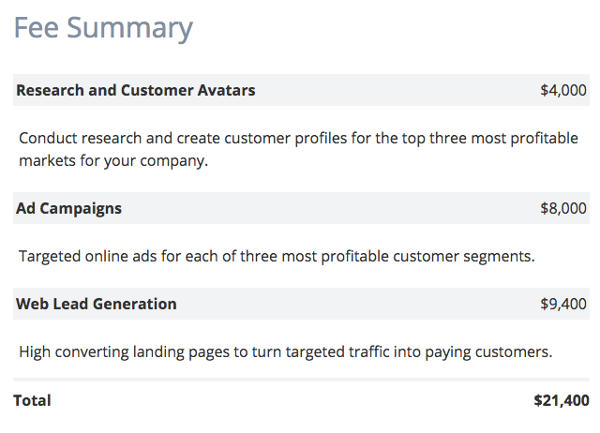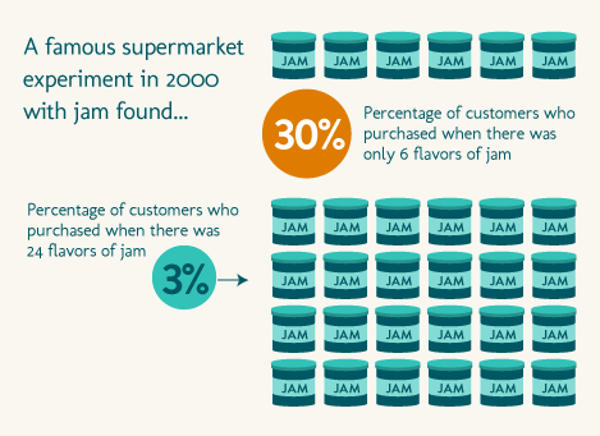Conversations about pricing can be uncomfortable, but they're a necessity for every marketer. Figuring out how to broach the topic tactfully—in a way that actually encourages prospects to become clients—gives you a tremendous advantage over competitors.
How do you pull it off?
By applying a few tried-and-true principles, you can navigate this key part of closing every sale.
Let's talk about how to do that.
Use price to persuade prospects to become clients
Cost is always on potential clients' minds. Even if you spend hours painstakingly preparing your marketing proposals, readers will often flip straight to the pricing section. Accepting that is the first step to conveying your price in a way that helps your chances of winning new business instead of hurts them.
Regardless of the project, apply the following six principles within your proposal pricing sections to help you land more clients.
1. Bundle your pricing
Even if you are confident in the value you can deliver to marketing clients, it's often tempting to try justifying each service by associating it with a specific cost.
The idea is that by listing every discrete service you plan to offer, you'll help would-be clients grasp the full extent of your value. As a result, you might end up with a pricing section that looks something like a receipt:

Looking at all that information gets overwhelming in a hurry, and not in the way you might hope. Instead of focusing on the value you can deliver, a prospect's eyes fix on all those dollar signs and zeroes. Your marketing solution (a combination of expertise and insights they can't find anywhere else) gets devalued into a commodity that's easy to compare with other service providers.
Your pricing section becomes more persuasive when you bundle all your discrete services into a single solution. By listing a price for the solution while describing all the included services, you keep people focused on value.
Here's how that might look:

Our research into over 25,000 sales contracts and proposals found that those with bundled pricing were 36% more likely to be approved than those with standard pricing.
2. Offer several options for clients to choose from
Bundling your services is a great first step, but your pricing can become even more effective when you offer multiple options.
A proposal with just a single solution is limiting: Prospects are faced with a binary choice—"take it or leave it." Often, out of a sense of powerlessness, they'll be tempted to leave it and move on to someone else.
However, offering a few options is empowering. Instead of choosing simply yes or no, prospects get to sift through various packages and choose the best solution.
One caveat here: don't offer prospects too many choices. That will overwhelm them.
Back in 2000, Yale and Stanford professors conducted an experiment at a supermarket. Researchers ran a station where shoppers could sample jam. The researchers tweaked the number of jams people could sample and tracked the effect on jam sales.
Here's what happened when the researchers increased jam options from six to 24:

When we're given too many choices, the sheer number can become demotivating. Keep that in mind for your pricing proposals. Our research found that offering two or three options increased revenue 32%, on average.
3. Use the rest of your proposal to create an upscale, professional context
Would you pay $20 for breakfast in a greasy-spoon diner?
How about in a swanky hotel?
Which one seems like a better deal?
Even if the meals are exactly the same, the context in which they're offered has a huge impact on whether we feel we're being ripped off or getting our money's worth.
A Vanderbilt University study found that customers were willing to pay more for a Budweiser when they knew it came from an upscale hotel than from a rundown grocery store.
We can apply those insights to our marketing proposals, too. Sloppy formatting or an unpersuasive structure creates a poor context, and when would-be clients check your prices they'll be less understanding about high figures. On the other hand, a concise, well structured, professional-looking proposal creates an "upscale" context.
Even if someone flips straight to the pricing section without reading the rest of the proposal, they'll notice the cover, layout, and design elements. All those details matter. The good news: it's entirely within your power to optimize those details to create the most professional context possible.
4. Use strategic upselling
Most of us try to upsell in some form or another because it's much easier to convince a current customer to invest a bit more money than to find a new customer.
You can do that within your proposal pricing sections as well: It's an opportune time and place for someone to select the best bundle and any add-on services they might need.
Here's an example from a proposal for marketing projects that we offer for free:

Some marketers stumble because they try to force upsell options into proposals by making suggestions that aren't logical extensions to the core services being offered. A marketer might try to upsell Web design or IT support, for instance, even though the potential client is interested primarily in dominating local search rankings.
It's much harder to upsell different services than add-ons, which enhance the value of the core service. Consider a car wash that upsells add-ons like premium waxing and wheel cleaners. That's an easier "yes" than trying to sell a sunshade or floor mats.
Just as with your primary service bundles, you can find a sweet spot here by offering a few upsell options, but not so many that people get overwhelmed.
Make it easier for clients to say 'yes'
Pricing is always a factor, but there's no reason why you need to minimize or hide it in your proposals. Fortunately, you can present your price in a way that's as persuasive as possible.
When you adhere to the key principles I've outlined in this article, your prospects will focus on the value of what you can deliver instead of just the financial cost. With an easy-to-understand pricing scheme that discourages comparison-shopping, you make it that much easier for clients to say "yes."
How do you address the pricing conversation in your marketing proposals? What works for you, and what have you struggled with? Leave a comment and let us know!




